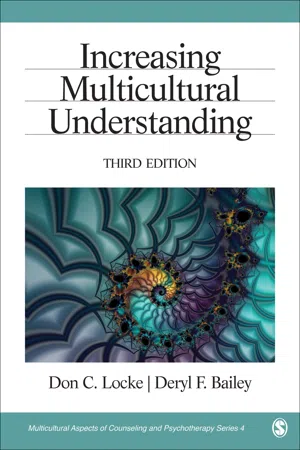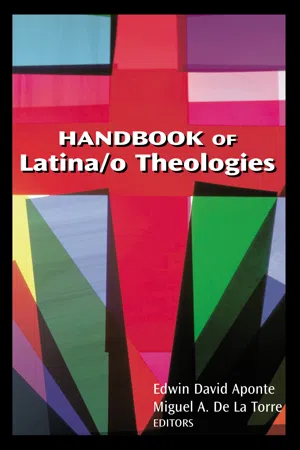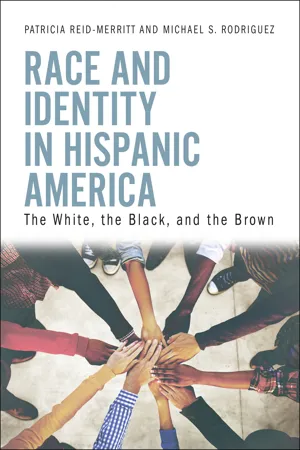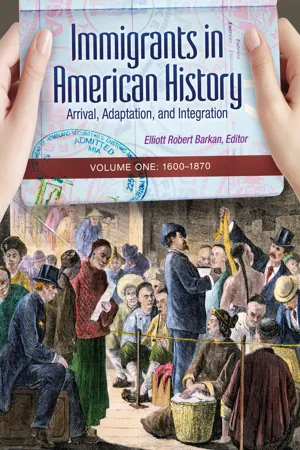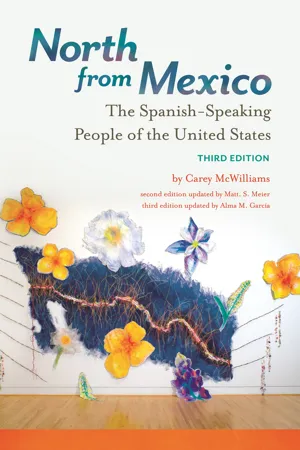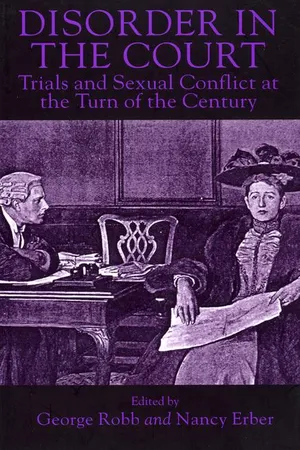History
Mexican Americans
Mexican Americans are people of Mexican descent living in the United States. Their history is intertwined with the complex relationship between Mexico and the U.S., including the Mexican-American War and subsequent migration patterns. Mexican Americans have made significant contributions to American culture, politics, and society, while also facing challenges related to discrimination and socioeconomic disparities.
Written by Perlego with AI-assistance
Related key terms
7 Key excerpts on "Mexican Americans"
- eBook - ePub
- Don C. Locke, Deryl F. Bailey(Authors)
- 2013(Publication Date)
- SAGE Publications, Inc(Publisher)
The criteria for identification as Mexican American have changed from census to census (e.g., born in Mexico, parents born in Mexico, Spanish speaking, Spanish surname). Defining Mexican Americans is a complex task. It not only involves its varied history, language, nativity, and social and economic integration in the United States but also their own perception of ethnicity (Hurtado & Arce, 1987). The main problem in defining the U.S. population of Mexican descent is its heterogeneity combined with its sociopolitical history.Arias (1986) called the rapid growth of the Hispanic population in the United States one of the “most compelling social developments in the last 25 years” (p. 27). No longer a rural group, they represent a significant number of metropolitan residents.Historically, Mexican Americans are a conquered people, beginning with Spain’s invasion of Mexico in the 1600s and ending with the annexation of Mexican territories by the United States in 1848 (Kiskadden & Rossell, 1979). It is important to understand that they were living in what today constitutes the southwestern United States before the Manifest Destiny philosophy made them a minority group with minimal rights. As the White population expanded west, settlers came to live within the Mexican territories and at that time expressed loyalty to the Mexican culture. For some 10 to 15 years, they lived peacefully and in cooperation with their Mexican neighbors. Conflict developed as the Mexicans struggled internally over governmental rule and the United States became anxious to increase its territory. Many Mexicans fought with Americans to achieve an independent state of Texas but soon found themselves foreigners as the Mexican government ceded the southwestern territories to the United States under the Treaty of Guadalupe Hidalgo. Hence, they became Mexican by birth, language, and culture and citizens of the United States by the might of arms (Garcia, 2002; Ortego, 1973).For the Mexican American, immigration from Mexico is motivated out of a desire for change and opportunity. A heavy value is placed on the need for change and achievement. Prejudice and discrimination against Mexican Americans, however, shut off many usual avenues to achievement. Damaging stereotypes, such as Mexicans being lazy, passive, and failure-oriented, have been reinforced by society and the media. These stereotypes have become internalized by some Mexican Americans who have lost contact with their ancestral culture. In contrast, Mexican Americans who are integrated with their traditional culture have a more positive image of themselves and of their group. Consequently, these persons are in a better position to make headway against prejudice and discrimination and thereby increase their chance for success. - eBook - ePub
- Dr. Edwin David Aponte, Dr. Miguel A. De La Torre(Authors)
- 2006(Publication Date)
- Chalice Press(Publisher)
mestizaje ” (Elizondo 2000a:13–16). Now these Mexicans of Indigenous, African, and Spanish descent were once again forced to encounter the process of mixing, but this time with the Anglo-Saxon culture of the United States.Since the beginning of their encounters, the Anglo-Saxon people have perceived the Mexicans as “other,” indeed as an inferior other (Machado 1999:89–90). This new pattern of relationships gave room to the racism and discrimination that has continued up to the present (Elizondo 2000a:13–18). Mexican Americans who live in the United States today are formed not only by all those Mexicans who were natives in this area and who were crossed by the borderline, but by all the Mexicans who later entered the United States legally or illegally. Today the people of Mexican descent are the largest Hispanic group in this country, followed by Puerto Ricans and Cubans (De La Torre and Aponte 2001:18).Who Are They? Mexicans, Mexican Americans, or Chicanos/as?
Although people of Mexican descent live throughout the whole United States, they prefer the areas of the Southwest–Arizona, California, Colorado, New Mexico, and Texas–as their place of residence. They are a growing population because of the youthfulness of the group, a significant reproductive rate, and the flow of legal and illegal immigrants from Mexico (Sáenz and Greenlees 1996:9–10). Most of the people of Mexican descent are at least bicultural in the sense that they are familiar with Mexican and Anglo cultural traits.1 This biculturalism does not represent a uniformity among them, but a diversity in terms of ethnic social orientation and loyalties, and use of language–Spanish, English, and/or Spanglish.2 For instance, first generation people, those born in Mexico, usually feel more comfortable with Spanish and are more loyal to their Mexican culture, while second, third, and subsequent generations born in the United States feel more comfortable with English or Spanglish - eBook - ePub
Race and Identity in Hispanic America
The White, the Black, and the Brown
- Patricia Reid-Merritt, Michael S. Rodriguez(Authors)
- 2020(Publication Date)
- Praeger(Publisher)
illegals, a moniker not applied to almost half of the undocumented population in the United States (i.e., individuals who reside in the country with expired visas). A prevalent ontological norm is the widespread presumption that Mexican Americans are either recent immigrants or first-generation citizens, hence the familiar probing question about one’s heritage upon making an acquaintance: “Yes, but where are you really from?” Another ontological norm is the generalized assertion that Hispanics, and Mexican Americans more specifically, either reject or are incapable of assimilating fully into the culture of the ethno-racial majority. Another generalized assertion is the (other-defined) norm that national origin is the essential character of Mexican Americans, not a pan-ethnic identity (Hispanic/Latino), citizenship status, or level of acculturation into American culture. The perniciousness of this norm is manifest in the historical treatment of Mexican Americans by the ethno-racial majority (repression, de facto discrimination, deportation, repatriation, and segregation) without regard to citizenship status or acculturation.Being Mexican American: Historical IdentityBeing Mexican American does not refer merely to national origin (Mexico) or phenotype (i.e., being brown). As the largest Hispanic group in the United States, Mexican Americans are playing a highly visible role in the Hispanicization of American popular culture. Mexican Americans are an interesting case study of that process because their presence in the United States has defied clear-cut categorization. Mexican Americans have been designated as white, other white, and as a distinct racial group. Mexican Americans are predominantly mestizos, the progeny of indigenous and Spanish intermarriage and miscegenation. However, the biracial connotation of the term fails to recognize the significant Afro-descendant lineage in Mexican history and culture. As one of the major ports of entry for the Atlantic slave trade (particularly through Veracruz), New Spain was supplied with Africans by slave traders to supplant the decimated indigenous populations. The Afro-Mexican presence is primarily concentrated in rural areas of the Mexican states Veracruz, Guerrero, and Oaxaca. Mexico’s census bureau estimates that 1.2 percent (or 1.4 million Mexicans) of the population self-identifies as Afro-Mexican, though many Afro-descendants were absorbed into the general population through intermarriage.19 Afro-Mexicans are increasingly asserting their own ethno-racial identity in the United States, even coining the term Blaxican to reflect their multi-raciality.20 - eBook - ePub
Immigrants in American History
Arrival, Adaptation, and Integration [4 volumes]
- Elliott Robert Barkan(Author)
- 2013(Publication Date)
- ABC-CLIO(Publisher)
Mexicans and Mexican Americans, 1870–1940
David S. Torres-RouffMexican Americans and Mexican immigrants to the United States sustained familial and local communities while generating new national and transnational connections between 1870 and 1940. Before 1908, most Mexican-descended people living in the United States were not immigrants but long-term residents of lands successively Indian, Spanish, and Mexican. Many extended families populated the greater Southwest, which consists of the territories annexed to the United States in the wake of the Mexican-American War. Between 1908 and 1929, Mexicans' great migration to the United States remade the U.S. Mexican community and sparked the rapid growth of local, regional, and national alliances, all with transnational ties. More than two million Mexicans crossed the border at least once between 1908 and 1929, and more than half of them remained in the United States, establishing permanent lives for themselves and their families. Mexican Americans also began to live and work outside the Southwest in large numbers, especially in cities. During the 1930s, Mexican immigrants and Mexican Americans faced both the Great Depression's privations and an uneven but spirited effort by old-stock Americans to force Mexican nationals and Mexican Americans south to Mexico. In response, Mexican Americans multiplied their connections to each other and to various nodes in the broader American working, religious, political, social, and cultural landscapes, even as they fought about citizenship and identity.1870–1908
With the Treaty of Guadalupe Hidalgo (1848), Mexico ceded Texas, New Mexico, Arizona, California and parts of Colorado and Utah to the United States. The treaty granted former Mexican citizens full U.S. citizenship. Regionally, residents farmed, ranched, engaged in skilled and manual labor for wages, or worked in professional capacities. Although mostly rural, Mexicans made up substantial portions of southwestern cities such as Albuquerque, El Paso, Los Angeles, San Diego, and Santa Fe. In rural and urban areas, immigrants predominantly worked in agriculture, light industry, and mining. - eBook - ePub
Recovering History, Constructing Race
The Indian, Black, and White Roots of Mexican Americans
- Martha Menchaca(Author)
- 2002(Publication Date)
- University of Texas Press(Publisher)
I concur with Weber, but must add that additional research on the Mexican Americans’ prehistory also needs to consider their ancient past in Europe and Africa, because Mexican Americans are a racially mixed people with a complex history of conquest. Thus, I begin with an outline of their prehistory that delineates their racial origins. The prehistorical analysis is based upon various sources, starting with nineteenth-century studies that attempted to describe the racial characteristics used to differentiate people and offer historical trajectories of the periods when contact occurred between the peoples of Europe, the New World, and Africa. Historical literature provides an overview of the peopling of Spain and the influence of the Phoenicians, Greeks, Romans, and Muslims on Spanish civilization. Archaeological and ethnohistorical studies provide information on settlement patterns in Spain, Mexico, the U.S. Southwest, and Africa. In essence, I have assembled literature that offers a composite overview of the Mexican Americans’ prehistory. The analysis of the arrival of Black people in Mexico closely follows the pioneering ethnohistorical research of anthropologist Alfonso Aguirre Beltrán and those scholars who have built upon his work. The account of the Indians is limited to the cultural complexes identified by archaeologists as having significantly influenced the cultural development and social organization of Mexico and the U.S. Southwest.Aztlán: History, Myth, or Mythologized History?
Mexican Americans are a people with a multiracial prehistorical past (Aguirre Beltrán 1946; Vigil 1984). Their White heritage began in Spain, the Indian in Mexico and the U.S. Southwest, and the Black in West Africa. Most Mexican Americans are a predominantly mestizo people: after Spain conquered Mexico in 1521, widespread intermixture of Spaniards and Indians occurred (Meyer and Sherman 1995:126). As David Weber notes, however, not all Mexican Americans are mestizo , since many Spaniards chose not to intermarry. To unravel this account I begin with an analysis of the indigenous background of Mexican Americans.The intellectual recovery of the Mexican Americans’ racial history started with the production of oral texts by working-class Mexican American college students. Exploring their indigenist roots was the primary concern of many social activists who had turned to the study of race as a means of contesting dehumanizing views that alleged that Brown people were poor because they were culturally deprived and racially inferior. They also entrenched themselves in the study of race to contest the racial aesthetics of the period, which elevated “being White” as the standard of beauty and viewed all Black and Brown phenotypes as markers of abnormality. On 31 March 1969 the Crusade for Justice, a Mexican American civil rights organization, organized the Chicano Youth Liberation Conference held in Denver, Colorado, where Alberto Baltazar Urista, professionally known as Alurista, recited the “Epic Poem of Aztlán” and introduced the seminal outline of the Mexican Americans’ indigenous foundations. His poetics challenged the politics behind the racial aesthetic philosophy of the period (Keller 1972:xiii; Rendón 1971:337).The conference was organized as a meeting place for Mexican American students to discuss how Anglo-American racism had shaped the Mexican experience in the United States. It was part of a larger national political movement—the Civil Rights Movement—in which people throughout the United States participated in hundreds of organizations to contest racial discrimination, in particular the forced social segregation of racial minorities (Omi and Winant 1994). As part of the Civil Rights Movement, Mexican Americans organized their own organizations to address the particular problems affecting their communities. Demonstrations, boycotts, strikes, and sit-ins became political vehicles that brought to national attention the Mexican-origin people’s poverty level, the farm workers’ struggle against unfair wages and working conditions, and perceived inequalities (e.g., police brutality, limited access to higher education, school segregation). Such ethnic consciousness was also manifested in the birth of the self-imposed label “Chicano” (Gómez-Quiñonez 1978) and the national mobilization of Mexican Americans into local and regional civil rights organizations, such as the United Farm Workers, the Alianza Federal de Pueblos Libres (Federal Alliance of Free City States), the Crusade for Justice, and the Brown Berets. The Chicano Movement was the national term used for the political organizations founded by Mexican Americans. - eBook - ePub
North from Mexico
The Spanish-Speaking People of the United States
- Carey McWilliams, Matt S. Meier, Alma M. García(Authors)
- 2016(Publication Date)
- Praeger(Publisher)
Oscar Handlin, the noted U.S. historian, provided an overview of immigrants. In his landmark book The Uprooted: The Epic Story of the Great Migrations That Made the American People, Handlin stated that “once I set out to write a history of the immigrants in American. Then I [Handlin] discovered that the immigrants were American history.” 5 Borrowing Handlin’s assertion, Mexican immigrants were and will always be part of American history. A demographic profile of Mexican immigrants residing in the United States is essential to understanding the twenty-first century’s political, economic, social, and cultural issues currently facing future generations of Mexican immigrants and later generations of U.S.-born Mexicans in the United States. Educators, politicians, and social-service providers cannot adequately design public policies for the problems facing Mexican immigrants, both authorized and unauthorized, without understanding key demographic features of this population. 6 Beginning in the early 1960s, the foreign-born population living in the United States experienced marked changes in their countries of origin, settlement patterns, population size, age, and other demographic characteristics. As the European-origin immigrant population in the United States declined, the U.S. foreign-born population, documented or not documented from Latin America increased. Under the provisions of the Immigration and Nationality Act of 1965, a preferential system replaced the existing quota system for countries in Latin America and Asia, regions that each received significantly larger allotments than European countries. Although many hoped that this policy would curb undocumented immigration, it did not due to economic stagnation in Mexico, the difficult bureaucratic process required under the Immigration and Nationality Act of 1965, and the pull from U.S - eBook - ePub
The Emergence of Mexican America
Recovering Stories of Mexican Peoplehood in U. S. Culture
- John-Michael Rivera(Author)
- 2006(Publication Date)
- NYU Press(Publisher)
My contention is that American public culture has asked a fundamental question of democracy that endures over the history of U.S. culture: What should the United States do about Mexicans, and what are their democratic rights and racial status in our democracy? Although this question may seem new to an American public that has only recently turned its attention to Mexican immigration, following the 2000 census and the release of Arau’s film, this inquest is historically rooted in a long line of political thinking about U.S. democracy’s understanding of itself as a sovereign nation-state, its transnational relationship to Mexico, and its capacity to incorporate Mexican people in the United States into the political landscape. This “Mexican Question”—what are the rights and status of Mexican people in U.S. democratic culture?—inevitably found its discursive roots in the geographic body of the nation itself: in the nation’s geographic imagination. Buried within the rhetoric of this rather simple question, therefore, is a complicated inquiry into the relationship between America’s geographic imagination as a (trans)continental empire and the political rights and racial status of Mexicans as an identifiable collective group who reside both within and outside the maps shown here. Deeply tied to the Mexican Question are two fundamental questions of U.S. democracy: Who is represented as American citizens, as an included people on U.S. soil, and what are the rights and status of collective minority groups that, in theory, became included in the body politic under colonial conditions?The discursive roots of Arau’s question began growing in the nineteenth century, when stories of Mexican peoplehood first appeared. Indeed, 150 years before Arau created his film, another Mexican looked at the California landscape and began an inquest into the invisibility of Mexican people in the legal spheres. Writing in the California newspaper El clamor público just seven years after the signing of the Treaty of Guadalupe Hidalgo in 1848, Californio, newspaper editor, and political philosopher Francisco P. Ramírez astutely questioned the new racial and political position that the Mexican people in the United States found themselves in:The United States’ conception of freedom is truly curious. This muchlauded freedom is imaginary. Civil Freedom is the right that links all citizens to society so that they can do as they please when it is not to the contrary of the established laws. But here in this fabulous country, he who robs or assassinates most is he who enjoys freedom. Certain people have no kind of freedom—this freedom, we say, is that which the courts deny to all individuals of color. It is enough that these institutions are unique in a country that tries to consume everything due to its “Manifest Destiny.” . . . The latter is that which affects our Californian and Mexican population directly. They particularly distinguish us by the title Greasers. (Ramírez 109–110)
Index pages curate the most relevant extracts from our library of academic textbooks. They’ve been created using an in-house natural language model (NLM), each adding context and meaning to key research topics.
